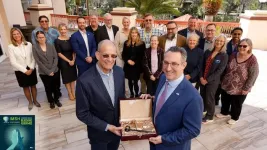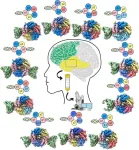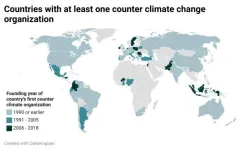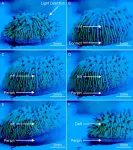(Press-News.org) Three NASA sounding rockets are set to launch from Poker Flat Research Range as early as Tuesday to learn more about three types of aurora — black, flickering and fast-pulsating.
The launch window is Jan. 21 through Feb. 5.
The University of Alaska Fairbanks Geophysical Institute owns Poker Flat, located at Mile 30 Steese Highway, and operates it under a contract with NASA’s Wallops Flight Facility, part of the agency’s Goddard Space Flight Center.
The launches will be the first of the season. As of April 2024, Poker Flat had launched 350 major sounding rockets and about 1,800 meteorological rockets in its 55-year history.
To receive updates about the launches, text PFRRLAUNCHES to 866-485-7614. Updates and a live feed will be provided on the Poker Flat Facebook page.
Probing the black aurora
The Black and Diffuse Aurora Science Surveyor mission is led by Marilia Samara of Goddard Space Flight Center.
Scientists want to understand the processes that create an optical aurora variation known as the black aurora, the result of a significant decrease in auroral particle precipitation in localized regions. Black auroras are dark and separate structured regions embedded within a larger and faint diffuse aurora.
“We want to know about the electrons inside regions of black aurora — how many, their energies and in which directions they are moving,” Samara said.
Diffuse aurora are usually not visible to the unaided eye because they are so spread out and faint. Observers in regions with frequent and intense auroras are more likely to see them.
To viewers, black auroras seem to cut out sections of auroral light. They move with the aurora and sometimes appear to move through the background aurora.
Samara, who focuses on aurora research, is quite familiar with Poker Flat. She last launched a rocket as lead investigator in March 2014 with an experiment aimed at improving understanding of the electron precipitation that creates the aurora. She has served as co-investigator on several other Poker Flat missions, including last year’s Beam-PIE, as well as for ground-based imaging campaigns as a postdoctoral researcher.
Samara’s doctoral thesis at Dartmouth College focused on electromagnetic waves created inside the aurora and used data from several NASA rockets launched at Poker Flat.
A double shot for aurora answers
The Ground Imaging to Rocket investigation of Auroral Fast Features mission consists of two rockets and aims to study the fastest observable auroral variations: the flickering aurora and the fast-pulsating aurora. The two are similar but have notable differences.
“Flickering has very regular periodicities, while fast-pulsating contains fairly random modulations,” said principal investigator Robert Michell, also with Goddard Space Flight Center.
“They are caused by electromagnetic waves interacting with electron distributions in space, scattering the electrons,” he said. “They are caused by different types of waves in different regions of space.”
The mission aims to learn about the wave-particle interactions.
Michell is also familiar with Poker Flat and was a co-investigator on Samara’s 2014 launch. He has supported many missions over the last 20 years, starting with the 2005 CASCADES mission to study plasma processes associated with the aurora. He was the lead graduate student from Dartmouth College.
The motor failure on the CASCADES mission is what led Michell into using ground-based optical imaging and radar observations to study the same plasma processes the rocket was targeting. As a result, Michell has conducted extensive ground-based auroral imaging and incoherent scatter radar campaigns from Poker Flat.
•••
Other agencies and institutions involved in the two missions include the Air Force Academy; UAF; Dartmouth College; University of California, Berkeley; University of Maryland; and Catholic University.
UAF participants in the two missions include professor Peter Delamere of the Geophysical Institute and College of Natural Science and Mathematics, Poker Flat chief scientist Don Hampton, Professor Emeritus Hans Nielsen and research professor Paul Bernhardt.
NASA will use two-stage Black Brant IX rockets for both missions. The 40-foot rockets can reach altitudes of more than 200 miles, making them ideal for studying auroras, solar physics and the upper atmosphere.
Optical auroral observations for both missions will be made at a Geophysical Institute observing site in Venetie, on the Teedriinjik (formerly Chandalar) River north of the Arctic Circle.
In addition to launching sounding rockets, Poker Flat is home to several scientific instruments designed to study the atmosphere and ionosphere. Poker Flat is the world’s only scientific rocket launching facility owned by a university.
Poker Flat will also be the site of a three-rocket launch in late March. That mission, led by UAF professor Mark Conde, will study the density, wind and composition perturbations that occur in Earth’s far upper atmosphere during auroral substorms.
CONTACTS:
• Kathe Rich, Poker Flat Research Range, 907-455-2103, ksrich@alaska.edu
• Sarah Frazier, NASA Goddard Space Flight Center, sarah.frazier@nasa.gov
• Rod Boyce, University of Alaska Fairbanks Geophysical Institute, 907-474-7185, rcboyce@alaska.edu
END
Three rockets will ignite Poker Flat’s 2025 launch season
2025-01-22
ELSE PRESS RELEASES FROM THIS DATE:
Jared M. Kutzin, DNP, MS, MPH, RN, named President of the Society for Simulation in Healthcare
2025-01-22
The Society for Simulation in Healthcare (SSH) has named Jared M. Kutzin, DNP, MS, MPH, RN, the Senior Director of the Simulation Teaching and Research (STAR) Center at The Mount Sinai Hospital, as its new President. He was elected this month during the annual International Meeting on Simulation in Healthcare (IMSH) in Orlando, Florida. He is the first Mount Sinai faculty member to hold this position and will serve as the 20th President of SSH.
Health care simulation is the practice of using immersive and innovative technology in ...
PET probe images inflammation with high sensitivity and selectivity
2025-01-22
Study Title: CD45-PET is a robust, non-invasive tool for imaging inflammation
Publication: Nature, January 22, 2025
Dana-Farber Cancer Institute authors: Ali Salehi Farid, PharmD, Jennifer E. Rowley, Harris H. Allen, Isabella G. Kruger, Soheil Tavakolpour, Kyle Neeley, Min Cong, PhD, Haneyeh Shahbazian, MD, Niki Dorafshani, Achraf Berrada, MS, Mohammad Rashidian, PhD
Summary: Researchers at Dana-Farber Cancer Institute have developed a breakthrough method to detect inflammation in the body using positron emission tomography (PET) imaging. This innovative probe targets CD45, a marker abundantly expressed on all immune cells but absent from other cell types. ...
Epilepsy patient samples offer unprecedented insights on brain ‘brakes’ linked to disorders
2025-01-22
Certain proteins found in the human brain have long been known to be critical to controlling how brain cells communicate with each other. So-called GABAA receptors are proteins that control the flow of ions into and out of cells. As they play such a vital role in how neurons slow down or stop firing, they have become the targets of many drugs for conditions such as epilepsy, anxiety, depression and insomnia.
Yet due to technical limitations and the delicate nature of studying human brain tissue, scientists have lacked a complete picture of how GABAA receptors, and their 19 subunits, ...
Your stroke risk might be higher if your parents divorced during your childhood
2025-01-22
People whose parents divorced during their childhood may be at a greater risk of stroke later in life, according to a new study published January 22, 2025 in the open-access journal PLOS One by Esme Fuller-Thomson of University of Toronto, Canada, and colleagues.
Each year, approximately 795,000 individuals in the U.S. have a stroke. Previous work has established many sociodemographic risk factors for stroke, as well as connections between adverse childhood events and stroke. In the new study, researchers looked specifically at the ...
Life satisfaction measurement tool provides robust information across nations, genders, ages, languages
2025-01-22
Data on almost 57,000 people from 65 countries suggests that the Satisfaction With Life Scale (SWLS)—a widely used research tool—generally holds up well when applied across diverse groups of people, underscoring its potential value in research and policymaking. Viren Swami of Anglia Ruskin University, U.K., and colleagues present these findings in the open-access journal PLOS One on January 22, 2025.
Life satisfaction is linked to a broad range of life areas, such as physical health, employment, and mortality. The SWLS is a questionnaire that measures an individual’s life ...
Adult children of divorced parents at higher risk of stroke
2025-01-22
TORONTO, ON – A recent study by researchers from the University of Toronto, Tyndale University and the University of Texas at Arlington found that older adults are at greater risk of having a stroke if they experienced their parents divorcing during childhood.
Among Americans aged 65 and older, one in nine whose parents had divorced reported that they had been diagnosed with a stroke, compared to one in 15 of those whose parents had not divorced during their childhood.
“Our study indicates that ...
Anti-climate action groups tend to arise in countries with stronger climate change efforts
2025-01-22
A new study suggests that countries with stronger commitments to protect the natural environment—regardless of national oil dependence or other economic interests—are more likely to see the establishment of counter climate change groups that aim to obstruct climate change action. Jared Furuta and Patricia Bromley of Stanford University, U.S., present these findings in the open-access journal PLOS One on January 22, 2025.
Prior research has highlighted how the fossil fuel industry and conservative think tanks and philanthropists have stoked climate change skepticism in the U.S. in order to serve their economic ...
Some coral "walk" towards blue or white light, using rolling, sliding or pulsing movements to migrate, per experiments with free-living mushroom coral Cycloseris cyclolites
2025-01-22
Some coral "walk" towards blue or white light, using rolling, sliding or pulsing movements to migrate, per experiments with free-living mushroom coral Cycloseris cyclolites
Article URL: https://journals.plos.org/plosone/article?id=10.1371/journal.pone.0315623
Article title: Walking coral: Complex phototactic mobility in the free-living coral Cycloseris cyclolites
Author countries: Australia, Saudi Arabia
Funding: The authors declare the research was funded by an Australian Research ...
Discovery of the significance of birth in the maintenance of quiescent neural stem cells
2025-01-22
A research group led by Kazunobu Sawamoto, a professor at Nagoya City University and National Institute for Physiological Sciences, and Koya Kawase, a pediatric doctor at Nagoya City University Hospital, has elucidated the significance of birth in the maintenance of neural stem cells (NSCs).
Birth is one of the most significant life events for animals. The transition from the intrauterine to the extrauterine environment causes various metabolic changes in individuals. Despite its significance, the role of birth in the developmental process remains incompletely understood. In the adult mammalian brain, NSCs are retained in the ...
Severe weather and major power outages increasingly coincide across the US
2025-01-22
An understanding of the relationship between severe weather and power outages in our changing climate will be critical for hazard response plans, according to a study published January 22, 2025 in the open-access journal PLOS Climate by Vivian Do of Columbia University, New York and colleagues.
Throughout the United States, large-scale power outages commonly occur alongside severe weather events. These combined events can be associated with major economic costs and health risks, as loss of power can disrupt medical equipment, heating or air conditioning, and other important systems. As severe weather ...







